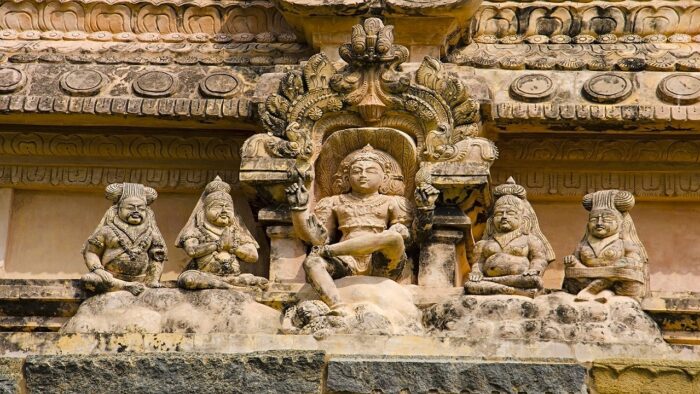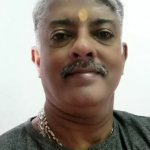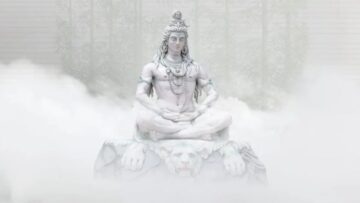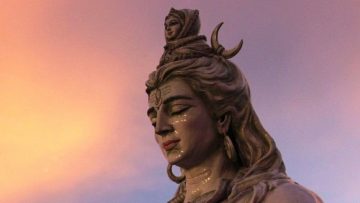Śaivasiddhānta is one of the many branches of Śaivism with its own distinct Śiva-revealed scriptures called Āgama-s (28 in total, generally known as Mūlāgama) dealing with every aspect of religion and ritual, with an independent and well developed philosophical doctrine and Yoga.
Fundamental aim of Yoga
Śaivāgama-s clearly state the basic aim of all Yoga-sādhana-s as:
आत्मा ध्याता मनो ध्यानं ध्येयः सूक्ष्मो महेश्वरः॥ ३॥
यत् परं परमैश्वर्यम् एतद्ध्यानप्रयोजनम् ।
ātmā dhyātā manō dhyānaṃ dhyēyaḥ sūkṣmō mahēśvaraḥ
yat paraṃ paramaiśvaryam ētad dhyānaprayōjanam ‖
(The great power that accrues by sincere and regular practice is the supreme aim and purpose of Yoga).
Benefits of Yoga practices
One of the important and basic Yoga practice prescribed in Śaiva Āgama-s is dhyāna. Here in the śaiva context, dhyāna has a different connotation than that offered by Patañjali. He says in the context of ‘japa’ that it consists of deeply meditating on the [inner] meaning of the praṇavamantra, which is the expression (vācaka) of the Supreme God (Īśvara) तज्जपस्तदर्थभावनम् ।
Patañjali defines dhyāna as
तत्र प्रत्ययैकतानता ध्यानम् ॥ ३।२॥
tatra pratyayaikatānatā dhyānam || Yoga Sūtra, 3:2
(Maintaining the same awareness (pratyaya) of a particular object without any interruption by other thoughts).
Śaivāgama-s clearly state that the basic aim of all yoga sādhana-s is the great power that accrues by sincere and regular practice and it is the supreme aim and purpose of Yoga. Benefits of other Yoga practices such as dhyāna are discussed in detail in the Śaiva Āgama-s.
Various visualizations (dhyāna) are also prescribed as part of different rituals.
The Mataṅgapārameśvarāgama, for instance, deals with dhyāna in detail and gives a different definition and purpose.
The present paper will briefly discuss these important points.
Methods of dhyāna
Proper and suitable places for the practice of dhyāna and the fruits gained such as the experiencing of various divine enjoyments are treated in the third chapter.
Conquering the tattva-s such as the prthivī by meditating on each one of them in one’s own body, the types of anumāna which is one of the means of knowledge are a few subjects discussed in the fourth paṭala.
To reassure the aspirants about the enormous and multifarious benefits to the individual as well as to the world at large, the Mgendrāgama categorically states in verses 10 and 11 that
येषु व्यस्तसमस्तेषु कृतयत्नस्य योगिनः ।
विभान्ति शक्तयो विश्वं व्याप्य भानोरिव त्विषः ।
न तमीष्टे नरः कश्चित् न रक्षोदानवामराः ।
रोरुचानमतीत्यैतान् दृक्क्रियाप्राणरोचिषा ।
yeṣu vyastasamasteṣu kṛtayatnasya yoginaḥ |
vibhānti śaktayo viśvaṃ vyāpya bhānoriva tviṣaḥ ‖
na tamīṣṭe naraḥ kaścit na rakṣodānavāmarāḥ |
rorucānamatītyaitān dṛkkriyāprāṇarociṣā ‖
(He who puts into practice either one or all the limbs of Yoga will definitely attain great powers (physical, psychical, etc.) like sun which cannot be countered or excelled by anything in the world).
The Śivadharmottara which is one of the earliest Śaiva texts speaks the importance of japa and dhyāna as follows:
यस्मात् सौख्यं च मोक्षं च योगादुभयमाप्नुयात् .
तस्मात् सर्वं परित्यज्य जपेद्ध्यायेच्च शङ्करम् .10.
The Mataṅgapārameśvarāgama assures that regular practice of intense prāṇāyāma and other related Yoga sādhanā definitely brings about complete control of all prāṇa activities which eventually brings forth such high benefits such as lightness (laghutva) of the body, physical lustre and high improvement in the intellectual faculties.
The Mataṅgapārameśvarāgama, (YP 2.8-10ab) gives a very clear and beautiful definition of dhyāna : It is an intense and unwavering love (acalā prītiḥ) towards the goal (lakṣyaṃ prati); it gives a very apt and practical example from everyday life : Just as a lover, fully attracted by the force of beauty of his beloved arising out of love, is not able to draw back his eyes fixed on his beloved (his object of attraction), so also a person who meditates should fix his entire mind on his object of meditation. Such a dhyāna is definitely fruitful.
The text goes as:
dhyānaṃ nāma na gauṇena cakṣuṣā divya-mūrtinā
lakṣyaṃ pratyacalā prītir yathā rāgabaleraṇāt
pralajjann api saubhāgyaśaktyā ākṛṣṭo nivāritaḥ
kāntāsaktāṃ dṛśaṃ prītyā na nivārayituṃ kṣamaḥ
tad dhyānaṃ dhyāyināṃ proktaṃ dhyānamārgaphalapradam |
We can notice that in this definition ‘bhakti’ plays a very important role; Śaivasiddhānta does not hold that any constant and continuous thinking as ‘dhyāna’. Along with firm and unbroken mental focus (on the chosen object), there should be the ‘bhakti’ as the driving force for that continuous thinking after which only it is held to be the ‘dhyāna’. Further, just as the lover is attracted to the beauty of his beloved so also in the ‘dhyāna’ the meditator due to his ‘bhakti’ gets attracted towards the deity, his chosen object of meditation. If we further analyze the above mentioned definition we find the adjective ‘nivāritaḥ’—for the lover. That is, even if the lover is prohibited or thwarted he is not able to draw back his eyes from his beloved. In the same way the devotee, even amidst many distractions that thwart him from his attention on his object of meditation, he continues his meditation fully impelled by his attraction, which, in other words, is his unflinching ‘bhakti’. These important points are highlighted in the commentary of Rāmakaṇṭha on the above mentioned verses. He also brings out the difference from mere [continuous] thinking (cintanamātram) which is of another level.
Samādhi
The Mataṅgapārameśvarāgama, 2.81-85ab, poetically describes the state of ‘samādhi’ using interesting metaphors:
भोगद्वाराण्यशेषाणि पिधाय परमे विधौ ।
तृप्तिदारुसमुत्थेन कवाटयुगलेन तु ॥
पञ्चधा संस्थितेनात्र लक्ष्यशय्याकृतास्पदः ।
शुद्धौजसा समालिङ्ग्य बुद्धिपत्नीं सुलालसाम् ॥
मनःप्रदीपप्रद्योतवितमस्के स योगिराट् ।
हृन्मन्दिरे सुखोद्दामयोगनिद्रासमाकुलः ॥
जितदर्पां मतिं कृत्वा सर्वाङ्गाह्लादितात्मवान् ।
शयीत सुचिरं कालम् अप्रबुद्धाक्षगोचरः ॥
असम्प्राप्तबहिर्द्वन्द्वः समाधौ संस्थितः सुधीः ।
Dhyāna as taught in the Sarvajñānottarāgama
The Sarvajñānottarāgama gives detailed procedure for the performance of formal dhyāna.
Before that the text speaks about the person who meditates, the object of meditation and the fruit of meditation.
The individual self is the meditator, the mind is the ‘dhyāna’, the object of meditation is Maheśvara who is most subtle and the fruit is the attainment of supreme power.
आत्मा ध्याता मनो ध्यानं ध्येयः सूक्ष्मो महेश्वरः॥ ३॥
यत् परापरमैश्वर्यम् एतद्ध्यानप्रयोजनम् ।
Aghoraśiva in his commentary on this verse explains manaḥ as mananam—continuous thinking, and that is ‘dhyāna’. Aghoraśiva also stresses that one should possess mental equanimity towards honour and dishonour, pleasure and pain and should be free from fear, overjoy and remorse.
मानामानौ समौ कृत्वा सुखदुःखे समे तथा ॥ ४ ॥
हर्षं भयं विषादं च संत्यज्य योगमभ्यसेत् ।
Aghoraśiva states on Sarvajñānottara, Yp. 2 that yoga is ‘the relationship between the meditator and the object meditated: ‘योगं ध्येयध्यातृसम्बन्धात्मकं’
The procedure of dhyāna

VARANASI, INDIA – DECEMBER 01, 2012 : Portrait of Shaiva sadhu, holy man on the ghats of the Ganges river in Varanasi, India . Close up
(Figure 1: Credit: istock – A Saiva sadhu in dhyana on the ghats of the Ganga river in Varanasi)
Before commencing dhyāna one makes sure that the upper row of teeth does not touch the lower one, as well as the tongue does not touch the space between the lips (skviṇyau) and then utters the Śivamantra with eyes slightly closed.
न दन्तैः संस्पृशेद्दन्तान् सृक्विण्यौ च न जिह्वया॥१०॥
किञ्चित् कुञ्चितनेत्रस्तु शिवं संयक् तदोच्चरेत्।
Aghoraśiva adds here that even during the performance of pratyāhāra—the preliminary limb of dhyāna, one should mentally repeat the [Śiva]mūlamantra that is of the form of the bījamantra:
प्रत्याहारकालेऽपि बीजात्मकमूलमन्त्रं मनसा स्मरेदित्यर्थः।
That the ‘dhyāna’ is not mere mental concentration but it should be accompanied by the kumbhakaprāṇāyāma which the the Sarvajñānottarāgama prescribes:
प्राणापानौ समौ कृत्वा सुषुम्नान्तरचारिणौ॥१३॥
तयोर्वृत्तिं निरुद्ध्यात्मा शिवं ध्यायेद्विचक्षणः।
In the Mgendrāgama, (YP:26cd-27ab) also we find that kumbhaka is to be practiced while doing dhyāna, japa, etc.
dhyānārcanajapādyeṣu dehatyāge ca śāṅkare //
kumbhako recakaśceṣṭo dīkṣāsaṃsthāpaneṣu ca /
Śiva who is beyond all the tattva-s is to be meditated, or one may even meditate on each of the tattva-s such as the kṣiti (earth). For, one may even meditate on these tattva-s as they are the body, as it were, of Śiva.
Mgendrāgama, (YP. 31cd-33ab):
dhyāyedadhvāntagaṃ devaṃ japettadvācakaṃ sadā// 31//
kṣityādīnyatha tattvāni tadrūpādhikṛtāni vā/
yasmānnācetanaṃ tattvaṃ siddhamapyupakārakam// 32//
śaivaṃ vapuriti dhyāyedato yadyatsamīhitam/
By the regular and intensive performance of ‘dhāraṇā’ which is in fact, the early stage of dhyāna, one directly perceives all the tattva-s beginning from the tanmātra-s and up to Sadāśiva and with the power of uttering the kṣurikāstramantra he finally enters into Śiva. This is declared to be the fruit of dhāraṇā.
The Sarvajñānottarāgama continues:
तदानुपश्यते सूक्ष्मं गन्धतन्मात्रमात्मनि॥२५॥
रसं तेजश्च स्पर्शं च शब्दतन्मात्रमेव च।
पश्यते क्रमयोगेन वर्णभावैः पृथग्विधैः॥२६॥
अहंकारं मनो बुद्धिं गुणमव्यक्तपूरुषम्।
अभिव्यक्तानि जानीयात् स्वधर्मगुणलक्षणम्॥२७॥
विद्यां कलां ततः कालं मायां विद्यां ततः परम्।
दृष्ट्वानुक्रमशः सर्वान् पुनरस्त्रेण भेदयेत्॥२८॥
विद्येश्वरं ततस्तत्त्वं ततः सादाशिवं परम्।
भित्वा तु क्षुरिकास्त्रेण ततः सूक्ष्मं शिवं विशेत्॥२९॥
We have seen just now that the repetition of the śivamantra is one of the basic accompanying rites of dhyāna; the same point is also corroborated in the Śivadharmottara:
Japa and dhyāna are complementary to each other and to be practiced alternatively:
जपश्रान्तः शिवं ध्यायेद्ध्यानश्रान्तः पुनर्जपेत् .
जपध्यानाभियुक्तस्य प्रसीदति महेश्वरः .
तस्मात् सर्वाणि कर्माणि परित्यज्य हि पण्डितः .
परमेशप्रसादार्थं सदैव ध्यानमभ्यसेत् .
Śivadharmottara, 10.
Another verion is:
जपश्रान्तः पुनर्ध्यायेत् ध्यानश्रान्तः पुनर्जपेत् |
as cited by Nigamajñānadeśika in his Ātmārthapūjāpaddhati.
Thus in brief these are various points that we find in some of the Āgama-s of the Śaivasiddhānta system. In the commentaries of Rāmakaṇṭḥa and Aghoraśiva we find many discussions regarding the difference between the Yoga taught by Patañjali and that expounded in the Śaivāgama-s on very important concepts and practices that I will reserve for future study.
Feature Image Credit: istockphoto.com
HinduMeditationTraditions&Techniques
Watch video presentation of the above paper here:
Disclaimer: The opinions expressed in this article belong to the author. Indic Today is neither responsible nor liable for the accuracy, completeness, suitability, or validity of any information in the article.










